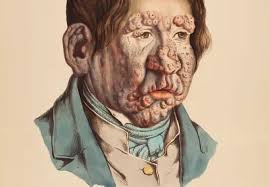 Acid fast rods, Mycobacterium leprae are responsible for the infection:M leprae.
Acid fast rods, Mycobacterium leprae are responsible for the infection:M leprae.
Chronic infectious disease.
Also known as Hansen disease.
Obligate intracellular parasite.
Characterized by visible skin lesions or peripheral neuropathy (or both) and is associated with stigma and discrimination.
Humans are the primary carriers of infection.
In the US, the 9-banded armadillo is a zoonotic reservoir.
Estimated that 6 million people worldwide have the disease.
Marked reduction in prevalence of the disease in recent decades.
The global prevalence is 1.4 per 10,000 population but 4.5 per 10,000 in 11 countries in which the disease is endemic.
Approximately 200,000 individuals worldwide and 200 to 300 people in the US are diagnosed with leprosy annually.
The most common route of transmission is through respiratory secretions, but skin contamination with tattooing and vertical transmission have been reported.
90% of cases are from endemic countries in Africa, Asia Latin America or the Pacific Islands.
200,000 new cases were detected worldwide between the years 2016 and 2019.
Approximately 7000 cases in the U.S., most of which are in immigrants.
Risk factors include poverty, genetic factors, rural living and exposure to armadillos in the U.S, immunosuppression and immuno deficiency.
The 9-banded armadillo is a zoonotic reservoir for M. leprae in the US.
Infects only humans.
M. leprae can not be cultured in vitro.
Clinical disease manifests in only a minority of infected patients.
Differential diagnosis includes: interstitial, granulomatous, dermatitis, granuloma annulare, granulomatous, dermatitis of immune deficiency, granulomatous drug irruption, psoriasis, and other mycbacterial or fungal infections.
Monkeys, armadillos and humans are the only known hosts for the organism Mycobacterium leprae.
The mechanism of transmission in unclear.
Because the organisms prefer cool temperatures the distal areas of the body are most commonly affected.
Leprosy is classified as multibacillary if there is six and more skin lesions, or is puucibacillary, if there are fewer than six lesions.
In the Ridley-Jopling classification there are five categories of leprosy: tuberculoid, borderline tuberculoid, borderline, borderline lepromatous, and lepromatous.
Incubation period averages 5-7 years but it ranges from 2-40 years.
Index cases are believed to be the main source of infection and prolonged contact with the patient is a known risk factor for its transmission.
Household contacts are at high risk for contracting the disease.
Household contacts also share a similar genetic background, which could contribute to a high susceptibility to leprosy than that in the general population.
The risk for leprosy among household contacts is 1300 times as high is that in the general population.
The most commonly involved areas include the skin, upper respiratory tract, testicles and peripheral nervous system.
Clinical manifestations include: thickened skin with symmetrical plaques or nodules, earlobe involvement, loss of hair including lateral eyelashes and eyebrows, upper respiratory symptoms of congestion, or epistaxis, nasal mucosal and cartilage damage leading to nasal collapse (saddle nose deformity), peripheral sensory neuropathy, destruction of distal digits.
Clinical manifestations and its spectrum related to interaction between the immune system and the bacterium.
Involvement of the facial skin can result in the classic “leonine” facies.
Sensory and motor nerve damage occur in the vicinity of skin lesions.
Hypergammaglobulinemia is observed because of increased Th2 cells, with reversal of albumin globulin ratio.
The diagnosis is clinical based on the typical signs of skin lesions with hypoesthesia and nerve enlargement.
Some patients develop a reaction presenting is urticarial, swelling of skin, lesions, fever, neuritis, erythema, nodosum, and permanent loss of motor and sensory nerve functions.
Skin biopsy is the only laboratory test that can definitely diagnose leprosy. PCR testing of the skin biopsy specimen has a sensitivity of 34 to 80% for paucibacillary leprosy and greater than 90% for multibacillary leprosy, with the specificity up to 100% for both types of lesions.
Early diagnosis and treatment can decrease disability and adverse psychosocial aspects and can reduce the risk of transmission.
Treatment results in gradual clearing of skin lesions.
Infection with Mycobacterium leprae is curable with a combination of dapsone, rifampin, and clofazimine.
Multibacillary therapy for leprosy includes a 12 month course of rifampicin, clofazimine, and dapsone, while paucibacillary leprosy requires a six month course of treatment.
Rifampin and rifapentine are recommended to prevent household contacts from acquiring the disease.
In patients with multibacillary leprosym bedaquiline monotherapy cleared M. leprae by four weeks of treatment and led to improvement in the appearance of skin lesions by seven weeks.
